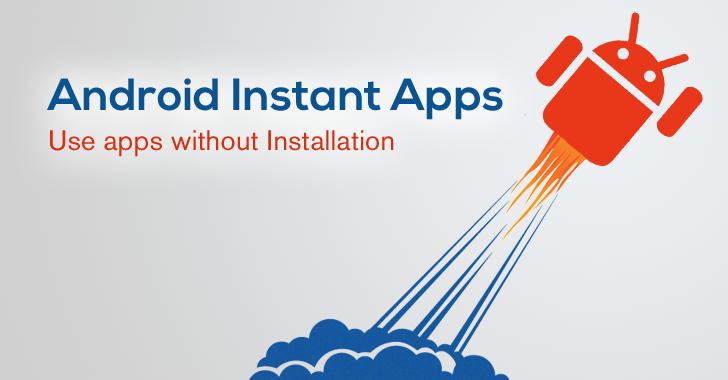Android Instant Apps is a new initiative by Google to make specific app activities available through the App Links feature that was introduced in Android 6.0 Marshmallow instead of having to download the entire app to your device.
At this point, it is an Early Access Program offered to select developers. Instant Apps was announced at the I/O conference last year, but is only now being launched in its test phase.
What are Instant Apps and How Do They Work?
Essentially, the same Android APIs and the same source code are used for Instant Apps, but there will be a version that’s slightly different from the original APK. To be clear, Instant Apps will not replace the original downloadable version of the app; it merely makes it available on demand using an app link.
These app links allow Instant Apps to be accessed using URLs that point to specific activities within the app. Put another way, different functionalities of a single app can be navigated to by using different URLs.
Instant Apps require no installation, but when you click on an Instant App link, it will use part of your device’s resources to run – just like any browser-based application would. The good part is that it won’t dump any unnecessary files into your device, or access unique device identifiers.
One point to note is that you can’t navigate to another activity within the app when you use Instant Apps; you will need to click on a different link to access that part.
When you use Instant Apps, the app will have some restrictions on what it can and cannot access on your device. For example, it won’t be able to run background services or do background notifications. However, as part of the Instant Apps experience, you can choose to install the original app, which will stay on your device even if you move out of the Instant Apps version of that app.
When Will Android Users Get Access to Instant Apps?
Since Instant Apps is still in the Early Access Program, it is being tested with apps like Wish, Periscope and a few others. Users won’t have access to it right now; only a few of them are being given access to the test apps.
Using the feedback collected from these tests, Google will eventually start rolling out more Instant Apps to more users across the Android user base.
What About Android Instant Apps on Chromebooks? Will They Come?
Our take is that Android Instant Apps will eventually come to Chromebooks because it is a URL-based service. Let’s take a step back and see what they have in common.
Instant Apps will work through Play Services, and it’s set up that way so older Android devices can take advantage of it as well. In this case, Google already confirmed in May 2017 at the I/O developers conference that all devices on Android Jelly Bean (4.1 through 4.3) and higher will be able to access Instant Apps.
Chrome OS also piggybacks on Play Services because, without it, a lot of apps won’t work on Chromebooks.
Put two and two together, and you now get a whole lot more than four!
What we envisage is that when Instant Apps are made available to the public, Chromebooks users will also have access to them via the Chrome browser. Instant Apps are essentially URL-based, tap-and-access versions of the full app, so there’s no reason it shouldn’t work, especially when both have Play Services working in the background.
But there’s a major limitation here. Not all Android apps will make it to Instant Apps. Google says that if a particular component does not work as an Instant App, the link will simply take the user to the developer’s website. That’s the same for unsupported devices as well.
That means, to begin with, Chromebooks on OS 53 and higher, as well as Android mobile devices running Jelly Bean and higher, will only get access to certain apps – and that, too, only the modules that a developer refactors for Instant Apps.
As such, it’s going to take at least a year or more for the bulk of Android apps to be available as Instant Apps. New Chromebooks launched in 2017, however, will get access to Android apps well before that.
So, now, it’s a question of timelines and overlaps. On one side, Google is bringing Android apps to all 2017 Chromebooks; and on the other side, Instant Apps is being developed as an almost redundant app experience for Chromebook users.
That said, Instant Apps will definitely hold appeal no matter whether you’re an Android mobile device user or a Chromebook owner. Why? Because it’s going to be much faster than a native app, will work much like a native app and there won’t be any installation or memory issues to worry about.
Instant Apps, therefore, seems to be an inevitable feature of future Chromebooks. That’s huge, because it will finally begin to erase the Great Divide between Android and Chrome OS devices, and that’s what Google has had in mind for a while now. Combined, the entry of Android Apps into Chromebooks and the entry of Instant Apps into Chromebooks will serve to boost Google’s presence in the desktop space.
And that represents a threat not only to Microsoft, the current leader in the space, but more so to Apple, whose MacBook Pro sales are already being adversely affected by the proliferation of Chromebooks, Surface Books and Surface Pro hybrid 2-in-1s.
The Microsoft vs. Apple fight for desktop presence looks like it may eventually give way to a three-way battle with the addition of Google.
Thanks for reading our work! Please bookmark 1redDrop.com to keep tabs on the hottest, most happening tech and business news from around the world. On Apple News, please favorite the 1redDrop channel to get us in your news feed.



